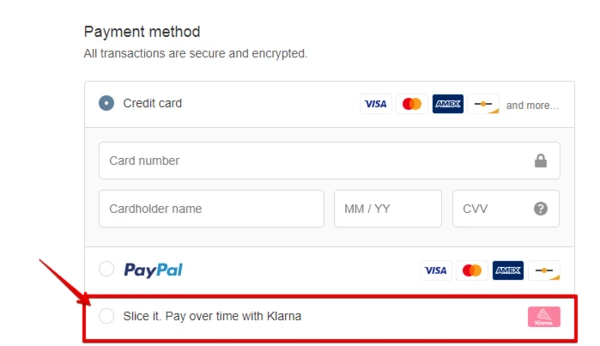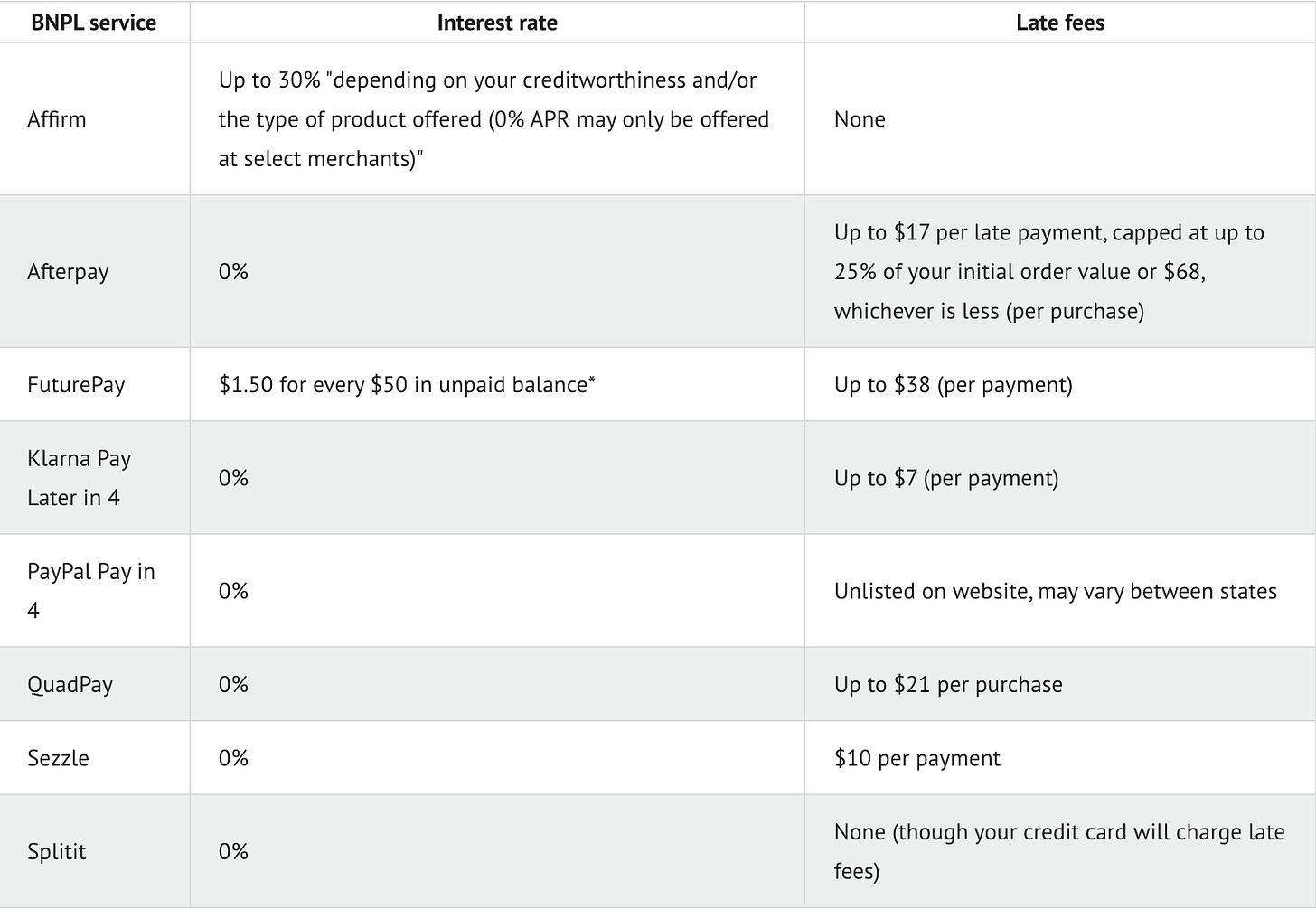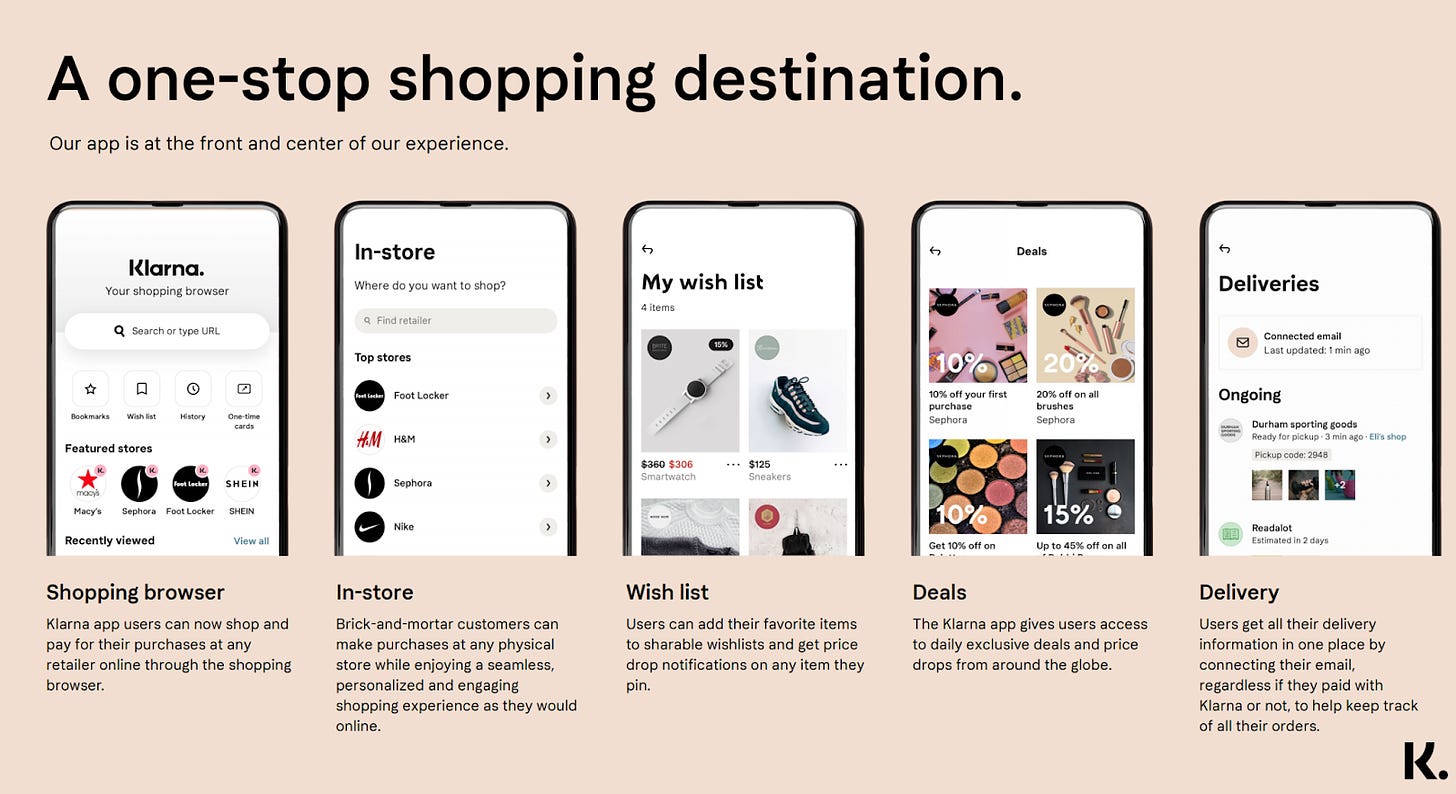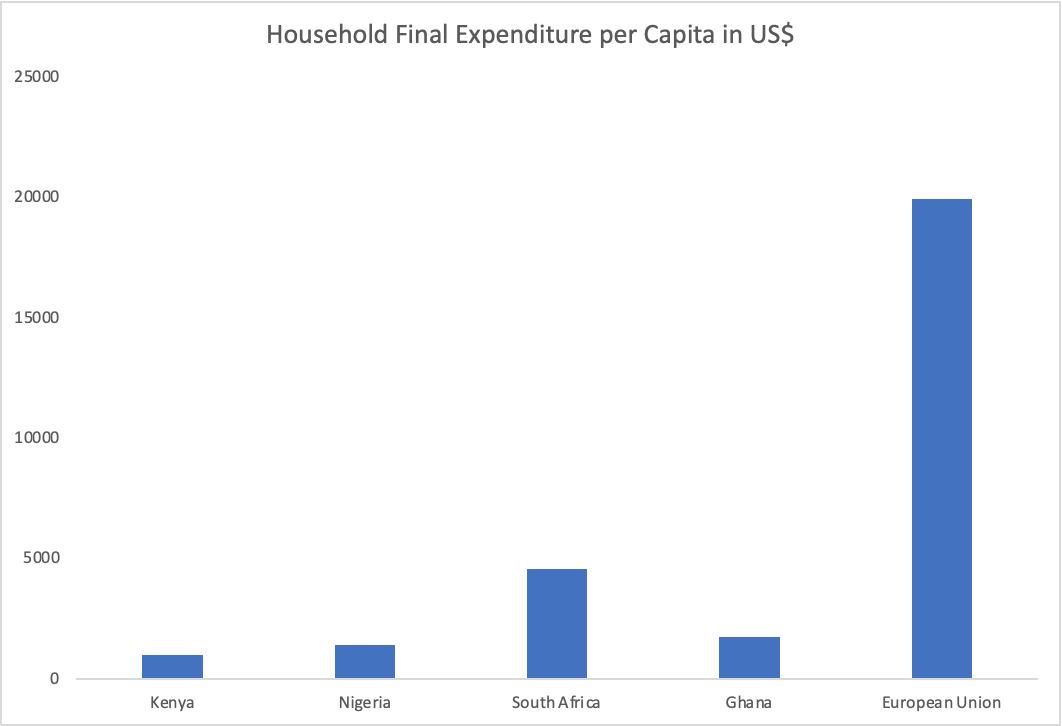Hi all - This is the 25th edition of Frontier Fintech. A big thanks to my regular readers and subscribers. To those who are yet to subscribe, hit the subscribe button below and share with your colleagues and friends. 🚀
Introduction
This week I cover the Buy Now Pay Later business analysing the commercial model behind the likes of Klarna and Affirm whilst discussing how the model could be applied to Africa.
The Buy Now Pay Later (BNPL) model has exploded in the past 24 months with significant moments marking its growth. These include, the recent fund raise by Klarna, that valued the firm at US$ 46 billion as well as Affirm’s IPO that had an implied valuation of US$ 12 billion. Recently, Goldman and Apple partnered to launch a BNPL feature on Apple Pay that’s being referred to as Apple Pay Later. Usually, Goldman Sachs and Apple don’t get into a business if they don’t think it’s lucrative. Clearly, BNPL has significant potential. The idea this week is to analyse the business and see what factors need to be present for it to succeed. As always, ideas around how BNPL can work in Africa are discussed.
What is BNPL
The term Buy Now Pay Later seems pretty self-explanatory. The idea behind BNPL is that consumers can at the point of purchase split the payments for an associated purchase into smaller, more “affordable” instalments. The idea is as ancient as civilisation as humans have always split purchases often through informal agreements. In the West, the concept of “lay away” used to exist where you’d buy something at a store by paying small instalments, once you finished paying, you would then pick up the item. In Africa, most BNPL agreements are informal arrangements driven on trust between the buyer and seller. People buy many things on BNPL including shoes, electronics, cars and insurance policies on informal agreements. In most African countries, shops are the biggest source of consumer credit. In the 70s and 80s, a number of retail stores used to offer BNPL for durable goods albeit to a very small formal sector minority.
BNPL as we now know it and as we discuss in this article is based on a more formal credit agreement that is designed around digital principles and is seamless. This is often presented as a checkout option at e-commerce sites.
The diagram above represent the checkout flow, a consumer upon selecting specific goods on an e-commerce website can proceed to select a BNPL payment method. This would then be followed by a page showing the breakdown of expected payments with the consumer being prompted to agree or disagree with the terms presented. These credit agreements are defined along a number of parameters;
Charging interest - Most BNPL players don’t charge interest particularly on short-term instalment transactions. They charge the merchant a higher take rate with the promise of lower cart abandonment and higher average order values (AOVs). If the customer pays on time, no interest is levied. Thereafter, late fees and deferred interest can be charged. Players such as Afterpay and Paypal’s Bill me later don’t charge interest on specific payments. Affirm on the other hand charges interest with the interest rate depending on your credit quality;
Credit reporting - BNPL players often don’t pull a credit report and don’t report payments once you’ve paid. These make them popular with thin-file borrowers. Unfortunately, upon missed payments some BNPL players report payments. This can be followed by a demand to clear the full balance and account closure. Some players such as Klarna go further to charge your credit card for the unpaid amount;
The table below shows a breakdown of the different BNPL players in terms of interest charged;
Why BNPL?
The diagram below from e-marketer.com shows the adoption of BNPL by generation.
It’s clear that the bulk of BNPL adoption is being driven by Gen-Z’s and millenials. The core reasons for the adoption of BNPL this age group are;
Negative perceptions around credit cards - The Global Financial Crisis had a major impact on the perception of credit cards by millennials particularly. Seeing parents struggle due to credit card debt led to lower adoption of credit cards by this generation. I also have a natural aversion to credit cards and use mine almost like a debit card, clearing payments almost instantly. The aversion to cards is driven by opacity and the cost of credit with APR’s in the USA running at around 16%;
Millennials and Gen-Zs have had their financial lives impacted by a number of significant macro events. The Global Financial Crisis, the digital transformation in production and lately the coronavirus. These have had the impact of making millennials more fiscally conservative due to the increasing volatility in their financial and economic lives. BNPL in practice is popular largely due to its transparency and clear repayment schedules enabling younger people to budget. This of course has to be seen in the context of crushing college debt that add to the financial obligations of this generation particularly in the U.S.A.
Additionally, the erratic economic environment has made merchants prefer to accept BNPL as a payment option as it allows customers to pay for goods that they previously wouldn’t have been able to afford. This has been the case with luxury brands such as Saks Fifth Avenue and Calvin Klein which sell particularly through Klarna. Improvements in technology and new business models such as open banking have accelerated the growth in BNPL. Klarna for instance has benefitted from open banking in Europe powering KYC and credit scoring. American players such as Affirm have benefited from partnerships with Plaid that also power onboarding and income verification.
Commercial Considerations
The idea behind BNPL is to make money by offering suitable financial arrangements that allow consumers to make purchases more “affordable” by deferring payments. This is often centred around e-commerce which is predicted to grow to over 22% of global trade by 2022. The diagram below presents the expected growth of retail e-commerce.
Different players have taken different approaches. Klarna for instance has taken a fully integrated approach offering the full gambit from a shopping app by signing up stores, offering delivery and logistics including returns, a debit card for offline payments and of course the BNPL payment option. This is super-charged by a loyalty program that enables customers to benefit from discounts from their favourite shops based on a positive repayment track record. Afterpay has adopted a similar business model.
Source: Klarna Investor Presentation
The idea behind this dynamic seems to be to build a positive marketplace dynamic where more customers attract more retailers/merchants with Klarna benefitting from improved data flows as well as higher gross merchant volume.
Most BNPL players report the following key metrics;
Gross merchandise volume (GMV) - this is basically the value of all merchandise purchased through a company’s BNPL product. This defines both the take rate that will be charged to merchants as well as the interest rate that may be charged to customers. The more the GMV the better. Klarna for instance recorded a GMV of US$ 58 billion in FY 2020, a 46% growth from the year prior. Affirm on the other hand recorded GMV of US$ 4.6 billion in FY 2020 with FY 2021 guidance of US$ 7.2 billion. The bulk of Affirm’s GMV, approximately a third of it, is derived from their partnership with Peloton. Afterpay had reported GMV, in their case reported as “sales” of US$ 11.1 billion;
Number of customers - ideally the more the customers, the more you can drive GMV. Customer acquisition is driven by novel marketing campaigns with Klarna being clear leaders in this regard. Klarna reports 87 million global customers with 18 million monthly active users globally. Affirm has 5.3 million active customers;
Number of merchants onboarded - Klarna is the clear leader with over 250,000 merchants signed up on their platform. The more the merchants, the more the potential customers and naturally increased GMV will follow.
The banking element of raising low cost funds and having low defaults through good origination practices. This then increases your interest income. Different players approach this differently. Afterpay for instance, given that it doesn’t charge interest, accounts for unpaid instalments as receivables and any defaults are accounted for as impairments on receivables. Klarna on the other hand reports credit losses whilst reporting its assets i.e. future receivables, as loans to customers.
In a nutshell, if you can attract more customers to pay through your payment option, accurately assess your clients creditworthiness and originate loans responsibly whilst growing your merchant network, then you have a wonderful business that will profitably ride the growth in e-commerce.
In China, Alipay and Wechat offer their own variants of BNPL that ride on their existing vast networks of merchants, customers, credit data and payments settlement architectures.
Different BNPL Formats
When you break down BNPL into its core principles. Different BNPL models emerge. In principle, the following core elements need to be in place for BNPL to work well;
Customer on-boarding and proper KYC including income and affordability verification;
Ubiquitous payments and settlements architectures;
Credit decisioning and origination capabilities - ideally fully digital;
Merchant relationships both on-line and off-line at checkout;
A source of funds - capital or a balance sheet;
Below is an attempt at a BNPL stack;
These basics though not exhaustive create four potential business models with players emerging in each space.
Direct merchant supplier - These are the fully integrated platforms like Klarna and Afterpay. The idea here is to do the full range of tasks within the stack from onboarding, payments, decisioning and acquiring merchant relationships. These go further and raise capital to provide the balance sheet. Klarna has already registered as a bank with the idea behind this being to acquire deposits via a debit card and thus have access to lower cost of funds. Tinkoff in Russia have BNPL as a payment option;
Multi-lender networks - Visa has built a BNPL API called Visa Instalments. The idea behind this is similar to the credit card system. Banks will pre-approve clients for specific amounts and these can then be used at check out or off-line POS environments. A client will automatically initiate a BNPL purchase through a card. In this instance, the provision of customers, their credit origination and settlements infrastructure is provided by the bank and visa continuing a long tradition. Mastercard is also working on a similar offering;
Credit card issuer - Banks like Citi, Chase Bank and others are working on their own proprietary systems. In this instance, banks have the capital, customers and credit origination but most likely will struggle to attract merchants onto their platforms. Additionally, questions can be raised about how tech savvy these banks are likely to be. Goldman Sachs has approached this through a partnership with Apple where I expect them to provide the balance sheet;
White Label providers - Firms such as Amount have built a white label BNPL service that integrates with banks to enable banks to participate in BNPL. Nonetheless, BNPL capabilities don’t necessarily translate into a successful BNPL business. The question that remains in this instance is where do the merchants come from. It’s very difficult to onboard merchants on to a proprietary payments acceptance system.
In my view the core elements of the stack are merchant acceptance and customer acquisition. Klarna has raised a mouth watering valuation in my view because they seem to be doing a good job on both of these fronts.
Regulatory Considerations
Naturally consumer credit is always subject to regulatory scrutiny due to the negative blowback that often arises when too much credit is in the hands of the wrong customers. The subprime mortgage crisis as well as the pay-day lending fiasco in the UK are “prime” examples. My main concern around the BNPL ecosystem is based on young people, often borrowing for the first time receiving negative credit reports due to defaults when purchasing “socks”. This then can negatively impact their ability to get a mortgage down the line. All that said, regulators such as the FCA in the United Kingdom have taken note and are making steps towards proper regulation of this sector. The Woolard Review being the first proper attempt at understanding the regulatory considerations around BNPL.
BNPL in Africa
The natural question is how you can build a BNPL business in Africa. This article on Techcrunch is a great resource on how Nigerian Fintech Carbon and Egyptian firm Shahry are approaching BNPL in their key markets.
It’s critical to note at the get go that Africa as a homogenous market doesn’t exist. Different countries have different regulatory regimes, different financial architectures and varying consumption levels. Nonetheless, it’s key to note what drove the success of BNPL in Europe and the USA and analyse whether these factors are present. The success of BNPL globally can be ascribed to three core factors;
A mature consumption culture powered largely by high income per capita and vast commercial infrastructure from delivery, shipping and retail stores;
A mature credit infrastructure particularly credit data that includes credit scores such as FICO scores and a credit culture built around trying to improve your credit score;
Trusted identity infrastructure that enables identity to be mapped to various variables such as credit history, rental payments, utility performance and other key variables.
Consumption Culture
This article by the Harvard Business Review is a great primer on the African consumer market, discussing elements such as consumption culture, the presence of an African middle class and other themes that are often bandied about when discussing consumption in Africa. The diagram below shows household expenditure in US$ for Nigeria, South Africa and Kenya compared to that of the European Union.
Source: World Bank Data
The diagram speaks volumes, South Africa has the highest expenditure per capita at around US$ 5,000 with Nigeria and Kenya at US$ 1,500 and 986 respectively. This will definitely have an impact on BNPL Gross Merchandise Volumes which are the core KPI for a BNPL firm. This raises a bigger issue as to whether we should organise our fintechs around consumption or production. It’s an issue I’ve raised before of how Fintech narratives are largely Western and applied wantonly in Africa where the underlying economic structures are completely different. People don’t need beautiful and seamless user experiences, they need functional and transformative products.
The biggest expense items in African households are mostly education and healthcare (excluding housing). BNPL products could be potentially built around these vectors which are arguably production based. Carbon’s founder Chijokie Dozie in the TechCrunch article aptly puts it as follows;
“We see a lot of potential in the Nigerian market for Carbon Zero. We do not believe we can blindly copy other BNPL players like Affirm or Klarna because they operate in markets that have an established offline and online retail market,... Carbon Zero will not only adapt to its environment to offer payment experience in the retail space but also in other areas where customers need to spread payments — in travel, education, and healthcare.”
Mature Credit Infrastructure
Most African countries excluding South Africa lack mature credit infrastructure. South Africa has advanced infrastructure, but with unemployment running at over 50% particularly for the youth, then this infrastructure is arguably not as valuable. By infrastructure, this should involve not only credit reporting but standardised credit scoring and a mature culture around this. For instance, in Kenya, credit infrastructure is binary “defaulted” or “not defaulted” information. This binary information is insufficient for forming a quick opinion about a borrower's credit worthiness for a specific loan.
Identity Infrastructure
I’ve spoken before about identity infrastructure on this article about Smile Identity (post script - Smile Identity recently raised US$ 7 million). The issue is largely about poor digital ID particularly in countries like Nigeria. In Kenya, there are robust ID infrastructure with the main issues being minority exclusion.
Going forward, ID infrastructures should mature to enable digital KYC sharing across a number of providers. This should also enable centralised matching of individual identity to “thing” ownership.
Summing it All Up
In such a scenario, the BNPL experience in Africa is sub optimal. Firms such as Aspira and Lipa Later in Kenya have arduous onboarding processes that in my view are not optimised for fraud detection. They then make up for this with higher interest rates between 3% and 7% per month. On top of this, they have to onboard merchants or in some cases build their own retail capabilities around fast moving electronics such as smartphones. In the absence of significant fund-raising, I’m not too sure about the viability of such business models
Nonetheless, some of the constraints above such as ID and centralised credit scoring can easily be solved through open finance principles. I have included the term open finance because a lot of valuable customer information in the continent sits on Mobile Money which should in principle be roped into open banking implementations if they’re to serve their purpose. Once this is done, then BNPL in Africa should be built around production and disintegrating the BNPL stack into its constituent parts. What this means for instance is that, M-Pesa already has a merchant network, any BNPL product should ride on this merchant network. M-Pesa using open banking principles can thus build credit decisioning infrastructure and ask capital providers e.g. banks to finance purchases on its Merchant network whilst providing settlements infrastructure for both merchant payments and direct debits for instalments. Of course, M-Pesa has existing credit products that may obviate the need for BNPL, but I think there’s a clear difference between an overdraft product such as Fuliza and BNPL.
Alternatively, visa can enable BNPL across its issuer banks. In Kenya for instance, there are approximately 11 million debit cards and over 300,000 credit cards in circulation.
Where mobile money doesn’t exist, players such as Flutterwave and Paystack can offer a number of these capabilities. Building a Klarna may be difficult, but I think building a BNPL product can be built. The random diagram below explains my thinking around this.
How this space evolves is anyone’s guess, but given the sheer entrepreneurial spirit within the continent, the increasing funding that African entrepreneurs are raising as well as the clear commercial potential for BNPL, I definitely expect to see interesting things happening in this space.
As always thanks for reading and drop the comments below and let’s drive this conversation.
If you want a more detailed conversation on the above, kindly get in touch on samora.kariuki@gmail.com;












This is an amazing breakdown. Doing some research for a client who is in this space and its really unlocking some great insights. Especially around the Consumption Culture of the African consumer. Would love to hear your take on the industries main barrier being time. Debt continues to get a bad name especially among Millenials and to a large extent a good portion of the middle class. So if this grows, isnt the industries biggest challenge overcoming people who just choose to buy later?
Hi, great breakdown of the bnpl stack. A big question that i have not seen explicitly adressed somewhere is about approval rates. What level of approval rates are these companies targeting and whats the threshold for attracting merchants